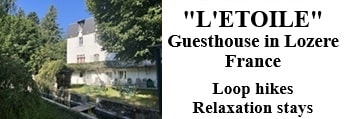77km bike tour at La Bastide-Puylaurent |
Take the D6 along the Allier, passing through Masmejean, the Château de Chabaleyret, Chabalier, Chasserades, Mirandol and Chazeaux. Turn right onto the D71 to Saint-Flour-de-Mercoire, crossing the Mercoire forest and passing the Mercoire abbey, Cheylard-l’evêque, Laubarnes, Les Huttes and L’Herm. In Saint-Flour, turn right towards the cemetery and the old Moulin de Saint-Flour, follow this small road to the statue of Sainte Germaine and the Domaine des Choisinets. Then turn left towards Langogne, then join the D326, then the D392, to reach Le Plagnal via L’Hermet-Chabalier and Saint-Alban-en-Montagne. Turn right onto the D292 towards Chaze-Neuve and Cellier-du-Luc, then follow the D192 to Luc. Then turn left onto the D906 for 1.7 km before turning left again onto the D76. Cross the Pranlac bridge, then continue on the D154 to Rogleton via Laveyrune. Finally, turn left onto the D906 to La Bastide-Puylaurent.

20,5km - 25km - 27,7km - 30km - 35,2km - 37km - 41,5km - 44km - 48,4km - 57,5km - 59,4km - 60km - 60,5km - 69km - 70km - 76,8km - 77km - 81km - 90km - 95,7km
Google Maps - Google Earth - GPX
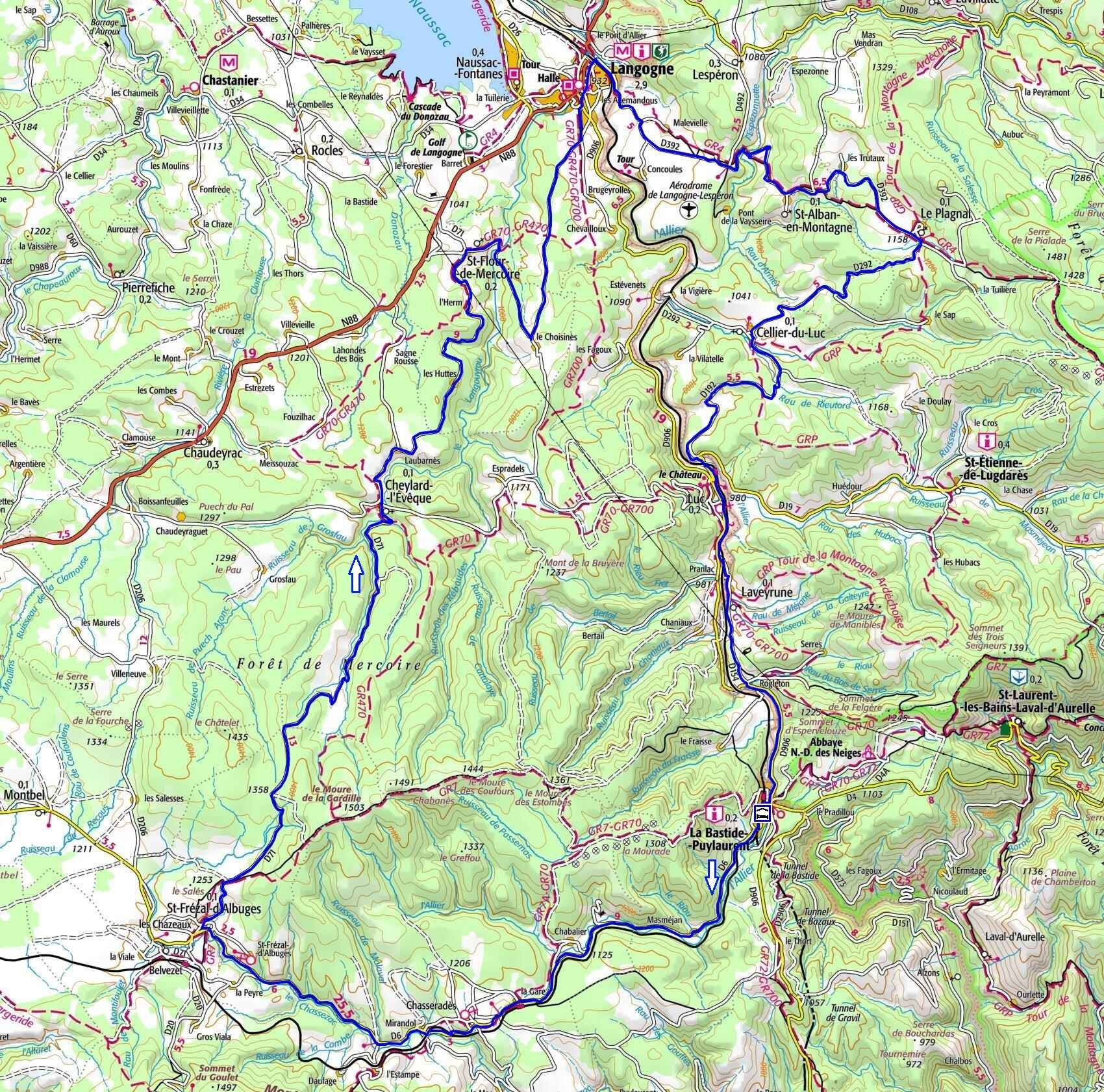


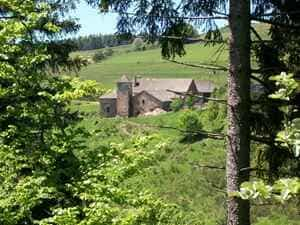
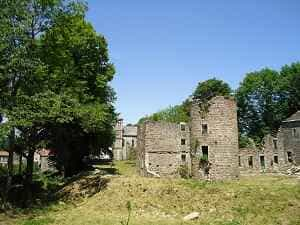
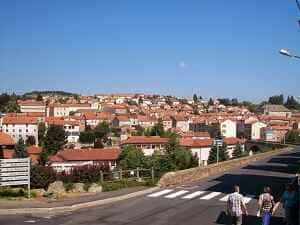
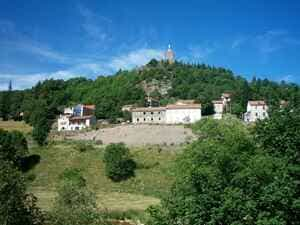

Distance: 77 km. Maximum altitude: 1365 m. Minimum altitude: 902 m. Cumulative elevation gain: 1215 m.
IGN maps: 2838OT - Largentiere, La Bastide-Puylaurent, Vivarais Cevenol. 2738SB - Le Bleymard, La Bastide-Puylaurent. 2737SB - Langogne, Grandrieu.
Print the route - Electric bike rental
The Abbey of Mercoire, founded in the 12th century thanks to a donation from Guillaume de Randon, Baron de Randon, saw its domain and influence grow rapidly. Initially linked to the Abbey of Mazan, it developed agricultural activities and benefited from donations, notably from the Randon family, reaching up to 50 nuns and 15 young nobles in training. Over the centuries, the abbey suffered successive declines: in the 15th century, the numbers decreased, and in the 16th century, the Wars of Religion led to its destruction by the Huguenot captain Matthieu Merle. Although partly rebuilt in the 17th century, the abbey gradually deteriorated, and a fire in 1773 almost completely destroyed it. With the French Revolution, the last nuns were expropriated, and the abbey was sold as national property in 1793, despite an attempt by the deputy Alexandre-Paul de Randon to preserve it. Transformed into a farm in 1875, it has now been owned by the Malzieu family since 1923.
The Choisinets estate, mentioned in the possessions of the lords of Randon since the 12th century, is marked by a turbulent history. In 1286, it was recognized as belonging to Guillaume de Randon, then, in the 14th century, Borbal de Chausines repelled an English attack, testifying to the strategic importance of the site during the Hundred Years' War. From 1500, the Bordal lineage was integrated into the Choisinets estate, and the de la Tour family, through several inheritances and sales, left its mark there by building a tower in 1650. In the 18th century, the Revolution disrupted the estate, which was divided up and partly ceded to the inhabitants. In 1840, the estate passed to Antoine Bonnefille, a childless farmer, who then gave it to Abbe Favier to create an orphanage. The latter was developed by the Brothers of the Christian Schools, who expanded the estate and built a church between 1863 and 1867. However, in 1908, anti-congregational laws forced the closure of the orphanage, and the property was then rented and operated by various managers. The estate suffered two fires: in 1904, damaging the stables and barns, then in 1926, which destroyed almost all the buildings except the farm. The roof of the church was rebuilt thanks to a collection. Subsequently, the property was sold and changed hands several times, until the Association "Le Choisinaît" became the owner in 2003, thus ensuring the preservation of this heritage rich in history.
Founded in 998, Langogne has a remarkable architectural heritage. The Romanesque church of Saint-Pierre, built in the 11th century and modified in the 15th and 17th centuries, is a major witness to its history. Its Burgundian Romanesque style and its historiated capitals make it an unmissable historical monument. The town also preserves an 18th century grain market, a place of regional exchange listed as a Historic Monument. Langogne was also marked by the Wars of Religion, in particular by the devastating passage of Mathieu Merle's Huguenot army in 1568, and has undergone reconstructions in the flamboyant Gothic style. Medieval architecture is omnipresent, with corbelled houses, mullioned windows and fortified towers. The town, once a commercial crossroads, is today known for its museums and historical sites, such as the Filature des Calquieres, a witness to its wool-producing past. Thanks to its natural setting between forests, hills and rivers, Langogne is an attractive destination for lovers of history, heritage and nature.
The Château de Luc, perched on a rocky spur overlooking the Allier Valley, is an impressive vestige of the feudal history of Gevaudan, today a department of Lozere. Built from the 6th to the 10th century and marking the border between Vivarais and Gevaudan, this medieval castle enjoyed a strategic position on the Regordane Way, an important passage route for pilgrims, crusaders and merchants. Its imposing structure, with keep, chapel and fortified ramparts, ensured its near-impregnability. Over the centuries, the castle was the scene of many historical events. It played a defensive role during the Hundred Years' War in 1380, when a band of mercenaries was repelled with the help of local knights. During the Wars of Religion in the 16th century, the castle remained loyal to the king and was protected by a royal garrison. However, in 1630, Cardinal Richelieu ordered its demolition to weaken the noble rebels. The castle then fell into ruin. In the 19th century, the keep was transformed into a chapel, and a statue of the Virgin Mary was installed there, giving the place a religious and symbolic vocation. In 1986, the castle was listed as a historic monument, and the association of Friends of the Château de Luc undertook its restoration. Today, the ruins of the Château de Luc continue to bear witness to the historical richness and complexity of the eras it has spanned, from the feudal period to the Revolution, including the Wars of Religion and the destruction ordered by Richelieu.
